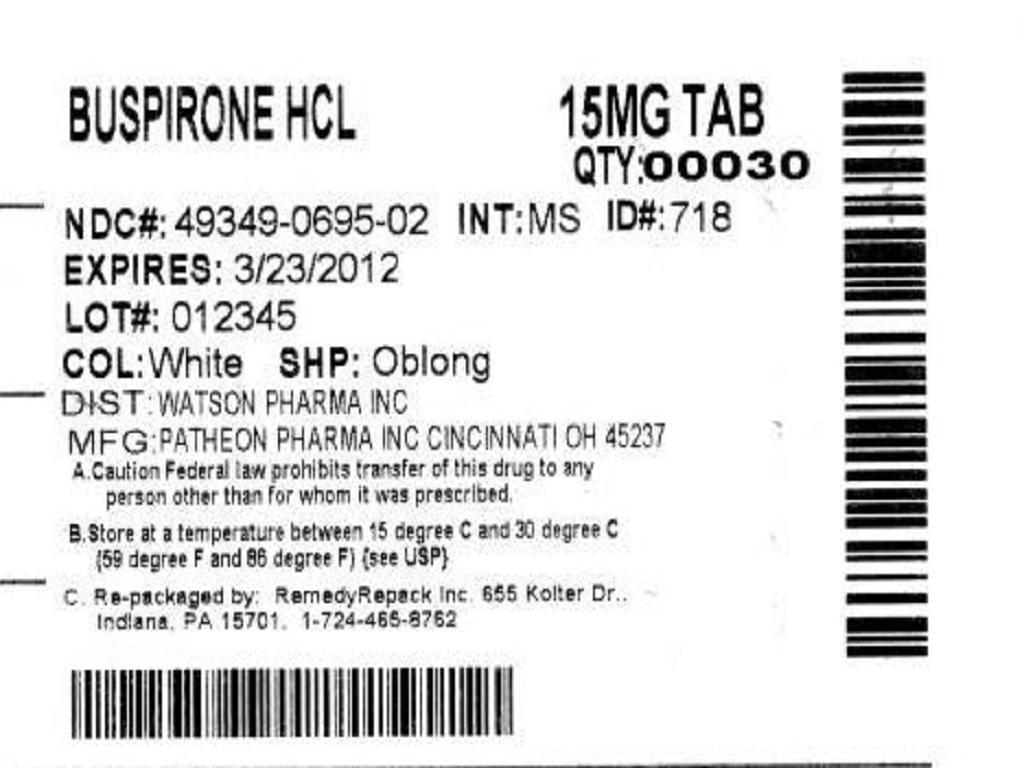Buspirone Hydrochloride
FULL PRESCRIBING INFORMATION: CONTENTS*
- BUSPIRONE HYDROCHLORIDE DESCRIPTION
- CLINICAL PHARMACOLOGY
- INDICATIONS & USAGE
- BUSPIRONE HYDROCHLORIDE CONTRAINDICATIONS
- WARNINGS
- PRECAUTIONS
- INFORMATION FOR PATIENTS
- LABORATORY TESTS
- DRUG INTERACTIONS
- DRUG & OR LABORATORY TEST INTERACTIONS
- CARCINOGENESIS & MUTAGENESIS & IMPAIRMENT OF FERTILITY
- PREGNANCY
- LABOR & DELIVERY
- NURSING MOTHERS
- PEDIATRIC USE
- GERIATRIC USE
- BUSPIRONE HYDROCHLORIDE ADVERSE REACTIONS
- DRUG ABUSE AND DEPENDENCE
- OVERDOSAGE
- DOSAGE & ADMINISTRATION
- REFERENCES
- INACTIVE INGREDIENT
- PACKAGE LABEL.PRINCIPAL DISPLAY PANEL SECTION
FULL PRESCRIBING INFORMATION
BUSPIRONE HYDROCHLORIDE DESCRIPTION

CLINICAL PHARMACOLOGY
Special Populations
Age and Gender Effects
Hepatic Impairment
Renal Impairment
Race Effects
INDICATIONS & USAGE
BUSPIRONE HYDROCHLORIDE CONTRAINDICATIONS
WARNINGS
PRECAUTIONS
GeneralInterference With Cognitive and Motor Performance
Potential for Withdrawal Reactions in Sedative/Hypnotic/Anxiolytic Drug-Dependent Patients
Possible Concerns Related to Buspirone's Binding to Dopamine Receptors
INFORMATION FOR PATIENTS
LABORATORY TESTS
DRUG INTERACTIONS
Psychotropic AgentsMAO inhibitors
Amitriptyline
Diazepam
Haloperidol
Nefazodone
Trazodone
Triazolam/flurazepam
Other psychotropics
Inhibitors and Inducers of Cytochrome P450 3A4 (CYP3A4)
Diltiazem and verapamil
Erythromycin
Grapefruit juice
Itraconazole
In a study in healthy volunteers, coadministration of buspirone (10 mg as a single dose) with itraconazole (200 mg/day for 4 days) increased plasma buspirone concentrations (13 fold increase in Cmax and 19 fold increase in AUC). These pharmacokinetic interactions were accompanied by an increased incidence of side effects attributable to buspirone. If the two drugs are to be used in combination, a low dose of buspirone (e.g., 2.5 mg q.d.) is recommended. Subsequent dose adjustment of either drug should be based on clinical assessment.
Nefazodone
In a study of steady-state pharmacokinetics in healthy volunteers, coadministration of buspirone (2.5 or 5 mg b.i.d.) with nefazodone (250 mg b.i.d.) resulted in marked increases in plasma buspirone concentrations (increases up to 20 fold in Cmax and up to 50 fold in AUC) and statistically significant decreases (about 50%) in plasma concentrations of the buspirone metabolite 1-PP. With 5 mg b.i.d. doses of buspirone, slight increases in AUC were observed for nefazodone (23%) and its metabolites hydroxynefazodone (HO-NEF) (17%) and meta-chlorophenylpiperazine (9%). Slight increases in Cmax were observed for nefazodone (8%) and its metabolite HO-NEF (11%). Subjects receiving buspirone 5 mg b.i.d. and nefazodone 250 mg b.i.d. experienced lightheadedness, asthenia, dizziness, and somnolence, adverse events also observed with either drug alone. If the two drugs are to be used in combination, a low dose of buspirone (e.g., 2.5 mg q.d.) is recommended. Subsequent dose adjustment of either drug should be based on clinical assessment.
Rifampin
Other inhibitors and inducers of CYP3A4
Substances that inhibit CYP3A4, such as ketoconazole or ritonavir, may inhibit buspirone metabolism and increase plasma concentrations of buspirone while substances that induce CYP3A4, such as dexamethasone or certain anticonvulsants (phenytoin, phenobarbital, carbamazepine), may increase the rate of buspirone metabolism. If a patient has been titrated to a stable dosage on buspirone, a dose adjustment of buspirone may be necessary to avoid adverse events attributable to buspirone or diminished anxiolytic activity. Consequently, when administered with a potent inhibitor of CYP3A4, a low dose of buspirone used cautiously is recommended. When used in combination with a potent inducer of CYP3A4 the dosage of buspirone may need adjusting to maintain anxiolytic effect.
Other Drugs
Cimetidine
Coadministration of buspirone with cimetidine was found to increase Cmax (40%) and Tmax (2 fold), but had minimal effects on the AUC of buspirone.
Protein Binding
In vitro, buspirone does not displace tightly bound drugs like phenytoin, propanolol, and warfarin from serum proteins. However, there has been one report of prolonged prothrombin time when buspirone was added to the regimen of a patient treated with warfarin. The patient was also chronically receiving phenytoin, phenobarbital, digoxin, and levothyroxine sodium. In vitro, buspirone may displace less firmly bound drugs like digoxin. The clinical significance of this property is unknown.
Therapeutic levels of aspirin, desipramine, diazepam, flurazepam, ibuprofen, propranolol, thioridazine, and tolbutamide had only a limited effect on the extent of binding of buspirone to plasma proteins (see CLINICAL PHARMACOLOGY).
DRUG & OR LABORATORY TEST INTERACTIONS
CARCINOGENESIS & MUTAGENESIS & IMPAIRMENT OF FERTILITY
Carcinogenesis, Mutagenesis, Impairment of FertilityPREGNANCY
Teratogenic EffectsPregnancy Category B
LABOR & DELIVERY
NURSING MOTHERS
PEDIATRIC USE
GERIATRIC USE
Use in Patients With Impaired Hepatic or Renal Function
BUSPIRONE HYDROCHLORIDE ADVERSE REACTIONS
Commonly Observed
Associated With Discontinuation of Treatment
Incidence in Controlled Clinical Trials
1
BuspironePlaceboAdverse Experience(n = 477)(n = 464)1
2
1
2
Other Events Observed During the Entire Premarketing Evaluation of Buspirone Hydrochloride Tablets
Postmarketing Experience
DRUG ABUSE AND DEPENDENCE
Controlled Substance ClassPhysical and Psychological Dependence
OVERDOSAGE
Signs and SymptomsRecommended Overdose Treatment
DOSAGE & ADMINISTRATION
REFERENCES
INACTIVE INGREDIENT
INACTIVE INGREDIENTSSILICON DIOXIDE
ANHYDROUS LACTOSE
MAGNESIUM STEARATE
CELLULOSE, MICROCRYSTALLINE
SODIUM STARCH GLYCOLATE TYPE A POTATO
PACKAGE LABEL.PRINCIPAL DISPLAY PANEL SECTION


Buspirone HydrochlorideBuspirone Hydrochloride TABLET
| ||||||||||||||||||||||||||||||||||||||||||||||||||||||||||||||||||||||||||||
PLEASE, BE CAREFUL!
Be sure to consult your doctor before taking any medication!